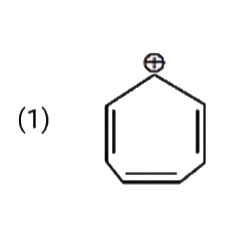Consider the following carbocations
1 . C6H5+CH2
2. C6H5+CHCH3
3 (C6H5)2+CH
4. (C6H5)3+C
The correct sequence of increasing order of thir stabilities is
1<2<4<3
4<2<3<1
1<2<3<4
1>2>4>3
The correct Answer is:C
To determine the increasing order of stability of the given carbocations, we need to analyze the effects of substituents on the stability of carbocations. The stability of carbocations is influenced by the ability of groups attached to the positively charged carbon to donate electron density through resonance (plus M effect) or inductively (plus I effect).
1. Identify the Carbocations:
- 1. C6H5+CH2 (Benzyl carbocation)
- 2. C6H5+CHCH3 (Allylic carbocation with one benzene and one alkyl group)
- 3. (C6H5)2+CH (Carbocation with two benzene rings)
- 4. (C6H5)3+C (Carbocation with three benzene rings)
2. Analyze the Stability Factors:
- Benzyl Carbocation (1): This carbocation has one benzene ring which can stabilize the positive charge through resonance. Its stability is moderate.
- Allylic Carbocation (2): This carbocation has one benzene ring and one alkyl group (CH3). The alkyl group has a +I effect, which can also help stabilize the positive charge, making it more stable than the benzyl carbocation.
- Carbocation with Two Benzene Rings (3): This carbocation has two benzene rings, which can provide significant resonance stabilization, making it more stable than the previous two.
- Carbocation with Three Benzene Rings (4): This carbocation has three benzene rings, providing the highest level of resonance stabilization, making it the most stable among the four.
3. Rank the Carbocations Based on Stability:
- The order of stability from least stable to most stable is:
- 1. C6H5+CH2 (Benzyl carbocation)
- 2. C6H5+CHCH3 (Allylic carbocation)
- 3. (C6H5)2+CH (Carbocation with two benzene rings)
- 4. (C6H5)3+C (Carbocation with three benzene rings)
Final Answer:
The correct sequence of increasing order of stability is:
1. C6H5+CH2 < 2. C6H5+CHCH3 < 3. (C6H5)2+CH < 4. (C6H5)3+C
- 1. C6H5+CH2 (Benzyl carbocation)
- 2. C6H5+CHCH3 (Allylic carbocation with one benzene and one alkyl group)
- 3. (C6H5)2+CH (Carbocation with two benzene rings)
- 4. (C6H5)3+C (Carbocation with three benzene rings)
- Benzyl Carbocation (1): This carbocation has one benzene ring which can stabilize the positive charge through resonance. Its stability is moderate.
- Allylic Carbocation (2): This carbocation has one benzene ring and one alkyl group (CH3). The alkyl group has a +I effect, which can also help stabilize the positive charge, making it more stable than the benzyl carbocation.
- Carbocation with Two Benzene Rings (3): This carbocation has two benzene rings, which can provide significant resonance stabilization, making it more stable than the previous two.
- Carbocation with Three Benzene Rings (4): This carbocation has three benzene rings, providing the highest level of resonance stabilization, making it the most stable among the four.
- The order of stability from least stable to most stable is:
- 1. C6H5+CH2 (Benzyl carbocation)
- 2. C6H5+CHCH3 (Allylic carbocation)
- 3. (C6H5)2+CH (Carbocation with two benzene rings)
- 4. (C6H5)3+C (Carbocation with three benzene rings)
The correct sequence of increasing order of stability is:
1. C6H5+CH2 < 2. C6H5+CHCH3 < 3. (C6H5)2+CH < 4. (C6H5)3+C
Similar Questions
Knowledge Check
Which of the following combinations give C6H5−CH3∣C∣CH2CH3−OH?
APhMgBr and H3C−O∣∣C−CH2CH3BCH3MgBrandPh−O∣∣C−CH2CH3CCH3MgBrandC6H5−O∣∣C−OC2H5DCH3CH2MBrandPh−O∣∣C−CH3
Decreasing order of stability of given carbocations is ?

(2) CH2=CH−⊕CH2
(3) C6H5−⊕CH2
(4) CH3−⊕CH−CH3
View SolutionGive the systematic IUPAC names of the following compounds :
CH3−C2H5∣CH−C≡C−CH2−C≡C−C2H5∣CH−CH3
View SolutionIdentify the reagents X, Y and Z.
C2H5ClX−−→C2H5CNY−−→C2H5CH2NH2Z−−→C2H5CH2NHCOCH3
View SolutionWrite IUPAC names of the following compounds:
CH3−CH3∣CH−CH2−CH2−CH3∣CH−CH3
View SolutionArraange the follwooing carbanions in decreasing order of their stability :
I. CH≡−C II. CH3−C≡−C III. CH2=−CH IV. CH3−−CH2
The correct choice is :
View SolutionIdentify A, B and C in the following reactions.
C6H5COOHPCl5−−→ANH3−−→BP2O5−−→C6H5CNH2,Ni−−−→C
View SolutionIdentify A, B and C in the following reactions.
C6H5COOHPCl5−−→ANH3−−→BP2O5−−→C6H5CNH2,Ni−−−→C
View Solution
